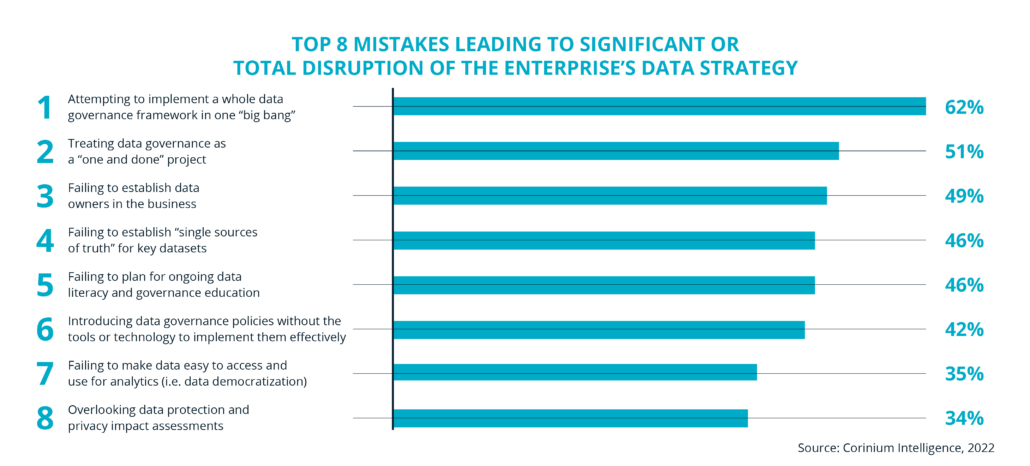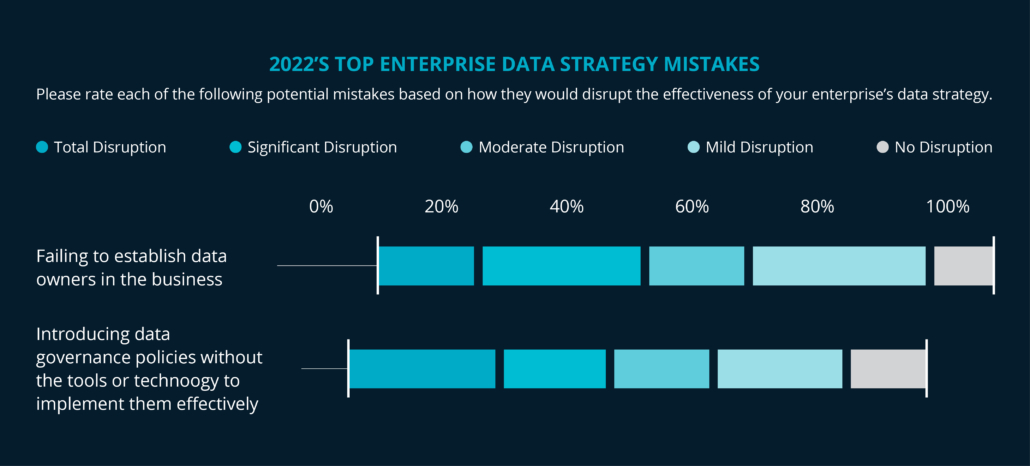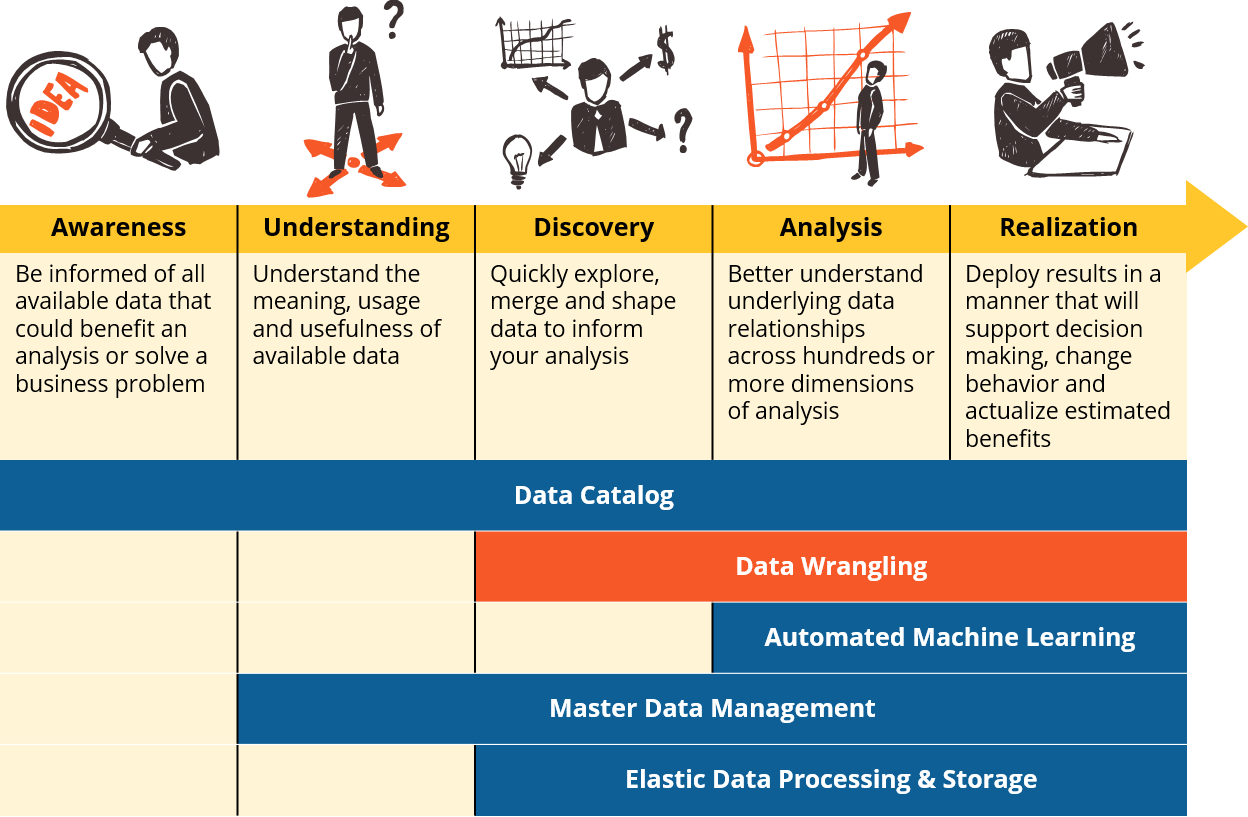Data governance. This concept is emphasized differently among different stakeholders. IT representatives have always held a more restrictive and cautious approach towards enterprise data access, while the business users continue asking for more and more data to become available.
As enterprise leaders continue to be energized by the transformational promise of the cloud, the need for a renewed strategy around who gets access to what data and how becomes obvious. In fact, 100 data and analytics leaders from middle-market companies reported in a survey that the eight mistakes most disruptive to their enterprise data strategy all have to do with data governance.

Data governance as a continual process
So what is data governance? Its central purpose is to improve trust in the data lifecycle. Trust in understanding where the data came from, how it’s been moved, if it’s been changed, and who can see it. How is this trust built? Through organizational policies and procedures that govern how data is managed at the enterprise.
What’s worrisome is that no phrase comes up more often with customers than, “I cannot trust the data.” The organization’s “currency” has not only become seemingless worthless, but also costly. Leaders and analysts alike cannot rely on what they’re seeing and decisions are being made blindly. Time is wasted arguing over which metrics are correct and the cycle is unending.
So, how can an organization avoid this total disruption of their cloud data strategy? Stop treating data governance as an end product – something to be completed – rather than a continual process. Data & Analytics leaders believe this is the biggest mistake enterprises make today – attempting to implement a whole data governance framework in one ‘bang bang’ and viewing it as a ‘one and done’ type of project.
Data management touches all aspects of an organization – which means a cultural shift is needed and this takes time to implement. Rolling out a comprehensive program should take a modular approach tactically and behaviorally.
Furthermore, effective data governance is never done. There will always be new data, new definitions, new technologies and new issues that arise over time. Without well-understood and trusted processes for addressing each of these areas, organizations run the risk of their program falling flat.
Building the right team is critical
While conversations about analytics tend to be saturated by technology, it is the people that make data governance work. A centralized team will define individual roles and responsibilities, ranging all the way from executive leadership to data stewardship. Business subject matter experts will work together with the data stewards to define key business processes and metrics, ensuring the consistency of data definitions to all areas of the organization. The data engineers and stewards are the key cogs to a governance operating model, which is why failing to establish these data owners in the business is considered a top risk to data strategy execution.
Technology powers successful implementation
While technology shouldn’t be the initial focus, leveraging modern governance tools will be essential in automating and scaling processes. 42% of the surveyed leaders were concerned with the successfulness of data governance policies if they’re introduced without the tools to implement them effectively.
These tools can range from spreadsheets to data catalogs to enterprise governance SaaS platforms. Choosing the right technology is entirely dependent on where you are on the journey. Since a full data governance implementation is exhaustive, companies can quickly become overwhelmed by attempting to accomplish too much, too soon. This is why our recommendation is typically labeled “agile data governance.” Start with a focused set of initiatives (dictionary, quality, lineage) and then leverage technology to automate and monitor these procedures. This will enable teams to tackle other governance disciplines (master data management, metadata management) without being stretched too thin. It is the proper blending of people and technology that drives successful data governance.

Training and data literacy translate to business value
Once the key personnel, processes, and technology are in place within your data governance organization, scaling literacy and democratizing data is how you turn all this hard work into business value. Educating users on the available governance documentation and technology enables them to quickly get up to speed on why, where, and how to access data. These training sessions are technical but also help to establish a data culture. Leaders must evangelize the governance program and generate buy-in from the users by reinforcing why these best data practices are needed to ensure they aren’t circumvented moving forward.
Consolidated and centralized access to data slows the value creation process. When too much of the analytics workload falls on IT resources, it restricts an organization from building competitive advantages effectively. Securely distributing and democratizing data to users across the business curates a smarter, faster organization. These technical and business users can spend more time in data analysis and less time dealing with data bottlenecks.
Typically, self-service and governance interests appear at odds with one another – one is an open policy, while the other is closed. But truthfully, the exact opposite is true – governance empowers self-service to be successful. With an enterprise more literate in data and educated on its lifecycle, the more it can confidently build value from it.
Protecting customer data and complying with regulations
Establishing rules and standards for data privacy, protection and security has always been a key tenet of the IT operating model. Global, state, and industry regulations have further tightened the data-handling standards that organizations must meet. And when we discuss data governance with our customers, the first thing they’re concerned about is remaining compliant and protecting all sensitive data.
Nonetheless, the last mistake highlighted by the surveyed leaders was overlooking data protection and privacy impact assessments. An assumption could be made that this would be considered a higher risk if leaders weren’t already confident in the data-compliant and protective culture that has existed for many years within their IT departments. But even if certain portions of the business are well versed in the protection of personally identifiable information, as data access is opened up to more users, more education will be required.
Viewing governance as a path to larger returns
As the appetite for data consumption increases, so should diligence in governance – it is needed now more than ever. Organizations should stop viewing governance initiatives as costs to the bottom line and start viewing them as mechanisms to generate larger returns from its most important asset (its data). In Breaking away: The secrets to scaling analytics, McKinsey identified what they defined as “breakaway companies” and found this group is, “…twice as likely to report strong data-governance practices.”
The organizational excuses for deprioritizing data management over other analytics initiatives is becoming less acceptable and more risky. External sources can be a catalyst for mid-market companies, providing the leadership and experience required to build their internal governance functions they need. There are many avenues to getting started with data governance – organizations just need to take one.
To learn more, read the whitepaper: Data Leadership: Top Cloud Analytics Mistakes – and How to Avoid Them


